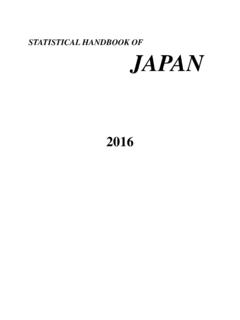Transcription of Green Buildings and Energy Efficiency - DIME
1 1 Green Buildings and Energy Efficiency Fangzhu Zhang & Philip Cooke, Centre for Advanced Studies, Cardiff University, UK, email: 1. Introduction: Today, Buildings worldwide account for up to 40% of total end-use Energy . The US, OECD/ Europe and Russia consume most of their Energy in the building sector (about 40%) (Figure 1) (IEA, 2008). There is over 50% saving potential in the building sector and thus it is considered as a potential sector to meet the challenges of global Energy and climate change. Due to Energy -intensive industrial production in China, the building sector only accounts for 19% of Energy demand.
2 But the share in China will grow swiftly with its economic development and urbanisation. The building sector is a driver of the world economy. For example, it contributed 9% of GDP in China and the EU. According to a report by McGraw-Hill Construction, the Green building market in both the residential and non-residential sectors was predicted to increase from $36 bn in 2009 to $60 bn in 2010 and in a range of $96-$140 bn by 2013. There is a significant opportunity for those entering this market (McGraw-Hill Construction, 2008). Figure 1: Global Energy demand by sector in 2005 (source: IEA, 2008) building heating and cooling are the most Energy -intensive activities, followed by electricity use for lighting and appliances (Harvey, 2009).
3 Greenhouse gas emissions from Buildings Energy use significantly exceed those from transportation. The increasing demand for residential and commercial building spaces in developing countries will further push up Energy consumption from building . It was predicted by International Panel on Climate Change (IPCC) that CO2 emissions from Buildings (including through the use of electricity) could increase from billion tonnes in 2004 to in 2030 under a high growth scenario (Figure 2) (Levine et al., 2007). Developing countries will contribute substantial increases in CO2 from the building sector. But such a building boom also offers an opportunity to commercialise Energy -efficient technologies to reduce CO2 emission.
4 Improved Efficiency in the building sector and de-carbonising the power sector could offer significant potential emissions reduction. 2 Figure 2. CO2 emissions from building sector under high growth scenario (including the use of electricity). (Source: Levine et al., 2007). Much effort has sought to apply renewable materials and renewable Energy resources in Buildings in order to use Energy efficiently and to reduce the carbon footprint. Reducing Energy use at lower costs in Buildings will offer greater potential to meet CO2 reduction targets than any other sectors. The Energy used for heating and cooling can be reduced through ventilation, heat sinks, the use of solar panel and improved insulation.
5 Electricity can be reduced through improved LED lighting or increased use of natural lighting and the use of Energy -efficient appliances. Integrated building design and the modification of building shapes, orientation and materials can also reduce Energy use (UNEP, 2008). It was reported that good practice regarding Green Buildings can reduce greenhouse gas emissions by as much as 70-80% (WBCSD, 2009). The main issues for Green building include raising global Energy awareness, changing consumer behaviour, setting building Energy codes and evolving Energy - Efficiency design and technologies. 2. building industry Urbanisation With economic development, total global Energy consumption is dramatically increasing over decades.
6 Total Energy use in Buildings depends on population size and density, and Energy Efficiency . Rising standards of living result in more Energy services required for heating, cooling, lighting and communicating. Aging populations and changing life styles lead to more single-person households. Urbanisation, especially in developing countries, demands higher-rise Buildings in urban areas. Energy use in high-rise Buildings is more efficient than that in conventional Buildings , especially than detached houses in the developed countries. But the impact of global urbanisation on Energy consumption could be reversed if the emerging prosperity encourages people to leave city centres and live in a countryside life style, commut daily to the city centre, clearly results in increases of Energy use not only in the Buildings but also transport.
7 The global urban population is expected to grow from 47% of the total in 2000 to 70% in 2050. Figure 3 shows the rising urban population 3 trend in developing countries like China, India and Brazil. The urban populations of China and India are continuing to grow rapidly to 2050, reaching 1 billion in China and billion in India, respectively. By 2050, it is predicted that about 73% of the Chinese population will be urban, increasing from 40% in 2005 (WBCSD, 2009). Brazil s urbanisation rate is beginning to reach saturation level and it is a much more urban country than others. The construction boom, especially in China, is increasing building Energy demand dramatically with economic development and living standard improvement.
8 Figure 3. The rising urban population in developing countries (China, India, Brazil) (WBCSD, 2009). building types: Commercial and residential Buildings In the property market, there are two types of Buildings : commercial and residential Buildings . The total existing building floors in 2003 was highest in China, as shown in Figure 4a. China has a higher percentage of residential space and much less floor space per capita than other countries like the US (Figure 4b) (WBSCD, 2007). Energy use for building in the US is significantly higher than in the other countries and is continuing increasing to Year 2030 (Figure 5).
9 Energy consumption in China will grow rapidly to approach European levels by 2030. During this period, commercial building Energy use in China will increase more than double. Energy consumption in Japan will remain the same level as now and only increase moderately in Western Europe. The consumption of Brazil is growing too, but not as fast as India or China. a b Figure 4: Existing building floor spaces (a) and average floor space per person (b) (Source: WBCSD, 2007) 4 Figure 5. building Energy projection by regions in 2003 and 2030 (Source: IEA, 2008). Energy use by end-use Energy consumption in residential building was about 82 EJ in 2005 and the associated CO2 emissions were Gt CO2, including indirect emissions from electricity use (IEA, 2008).
10 Energy consumption includes space and water heating, cooling, lighting and the use of appliances. As shown Figure 6, space heating is the most important Energy use in residential Buildings , accounting for over 50% of total end Energy use. Although Energy consumption by space heating has increased due to urbanisation and increased floor space over the years, its share of total Energy consumption reduced from 58% in 1990 to 53% in 2005 because of higher Energy Efficiency of space heating equipment and improved building insulation. Figure 6. household Energy use by end-use, among the surveyed countries of IEA 19. (Source: IEA, 2008) 5 Electricity used for household appliances grew from 1990 to 2005.






